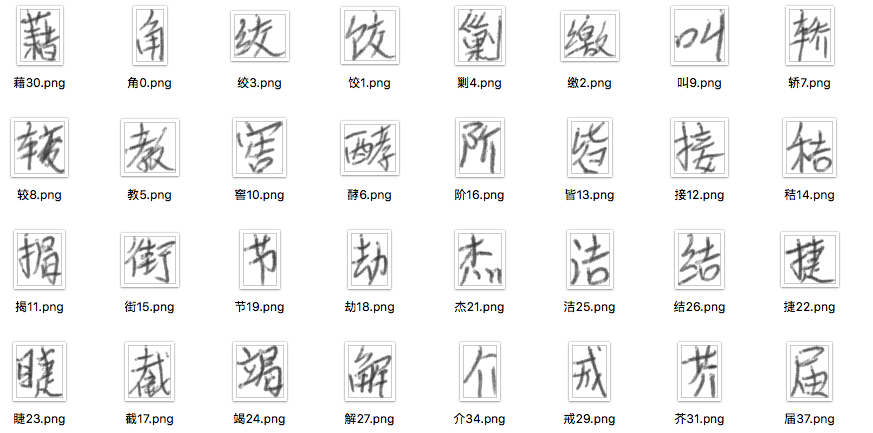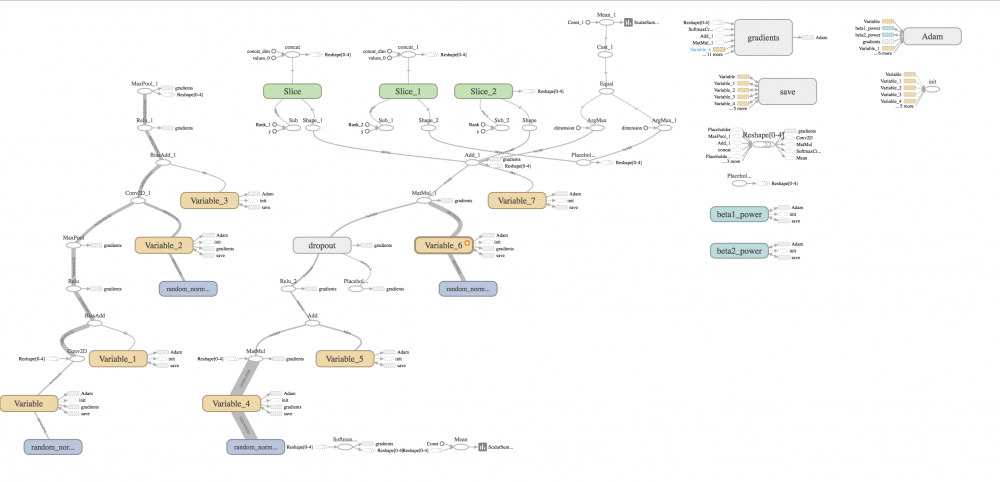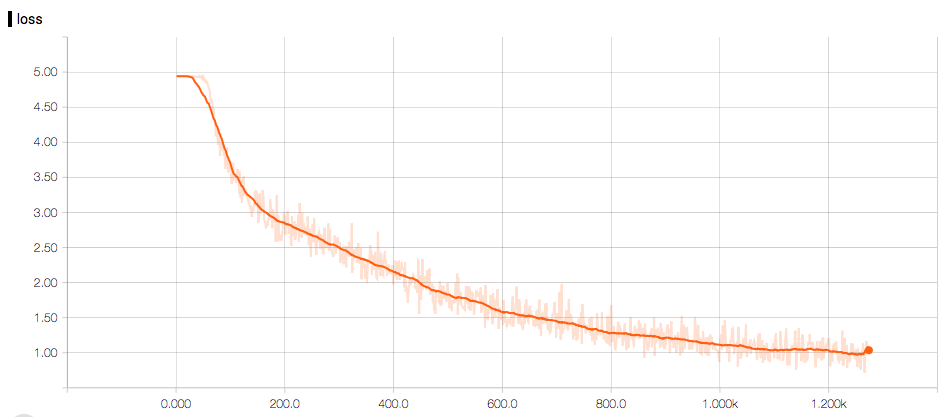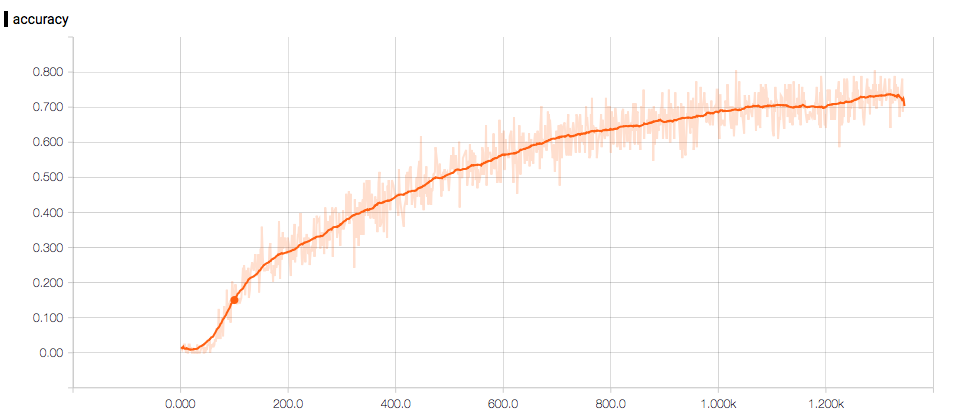TensorFlow练习22: 手写汉字识别
MNIST手写数字数据集通常做为深度学习的练习数据集,这个数据集恐怕早已经被大家玩坏了。本帖就介绍一个和MNIST类似,同时又适合国人练习的数据集-手写汉字数据集,然后训练一个简单的Deep Convolutional Network识别手写汉字。
识别手写汉字要把识别手写洋文难上很多。首先,英文字符的分类少,总共10+26*2;而中文总共50,000多汉字,常用的就有3000多。其次,汉字有书法,每个人书写风格多样。
手写汉字数据集: CASIA-HWDB
下载HWDB1.1数据集:
$ wgethttp://www.nlpr.ia.ac.cn/databases/download/feature_data/HWDB1.1trn_gnt.zip # zip解压没得说, 之后还要解压alz压缩文件 $ wgethttp://www.nlpr.ia.ac.cn/databases/download/feature_data/HWDB1.1tst_gnt.zip
这个数据集由 模式识别国家重点实验室 共享,它还共享了其它几个数据库,先mark:
- 行为分析数据库
- 三维人脸数据库
- 中文语言资源库
- 步态数据库
- 掌纹数据库
- 虹膜库数据
手写汉字的样子:
import os
import numpyas np
import struct
import PIL.Image
train_data_dir = "HWDB1.1trn_gnt"
test_data_dir = "HWDB1.1tst_gnt"
# 读取图像和对应的汉字
def read_from_gnt_dir(gnt_dir=train_data_dir):
def one_file(f):
header_size = 10
while True:
header = np.fromfile(f, dtype='uint8', count=header_size)
if not header.size: break
sample_size = header[0] + (header[1]<<8) + (header[2]<<16) + (header[3]<<24)
tagcode = header[5] + (header[4]<<8)
width = header[6] + (header[7]<<8)
height = header[8] + (header[9]<<8)
if header_size + width*height != sample_size:
break
image = np.fromfile(f, dtype='uint8', count=width*height).reshape((height, width))
yield image, tagcode
for file_namein os.listdir(gnt_dir):
if file_name.endswith('.gnt'):
file_path = os.path.join(gnt_dir, file_name)
with open(file_path, 'rb') as f:
for image, tagcodein one_file(f):
yield image, tagcode
# 统计样本数
train_counter = 0
test_counter = 0
for image, tagcodein read_from_gnt_dir(gnt_dir=train_data_dir):
tagcode_unicode = struct.pack('>H', tagcode).decode('gb2312')
"""
# 提取点图像, 看看什么样
if train_counter < 1000:
im = PIL.Image.fromarray(image)
im.convert('RGB').save('png/' + tagcode_unicode + str(train_counter) + '.png')
"""
train_counter += 1
for image, tagcodein read_from_gnt_dir(gnt_dir=test_data_dir):
tagcode_unicode = struct.pack('>H', tagcode).decode('gb2312')
test_counter += 1
# 样本数
print(train_counter, test_counter)

由于时间和系统资源有限,我只使用数据集的一部分(只识别最常用的140个汉字)。
训练模型
- 模型架构参看论文: Deep Convolutional Network for Handwritten Chinese Character Recognition
import os
import numpyas np
import struct
import PIL.Image
train_data_dir = "HWDB1.1trn_gnt"
test_data_dir = "HWDB1.1tst_gnt"
# 读取图像和对应的汉字
def read_from_gnt_dir(gnt_dir=train_data_dir):
def one_file(f):
header_size = 10
while True:
header = np.fromfile(f, dtype='uint8', count=header_size)
if not header.size: break
sample_size = header[0] + (header[1]<<8) + (header[2]<<16) + (header[3]<<24)
tagcode = header[5] + (header[4]<<8)
width = header[6] + (header[7]<<8)
height = header[8] + (header[9]<<8)
if header_size + width*height != sample_size:
break
image = np.fromfile(f, dtype='uint8', count=width*height).reshape((height, width))
yield image, tagcode
for file_namein os.listdir(gnt_dir):
if file_name.endswith('.gnt'):
file_path = os.path.join(gnt_dir, file_name)
with open(file_path, 'rb') as f:
for image, tagcodein one_file(f):
yield image, tagcode
import scipy.misc
from sklearn.utilsimport shuffle
import tensorflowas tf
# 我取常用的前140个汉字进行测试
char_set = "的一是了我不人在他有这个上们来到时大地为子中你说生国年着就那和要她出也得里后自以会家可下而过天去能对小多然于心学么之都好看起发当没成只如事把还用第样道想作种开美总从无情己面最女但现前些所同日手又行意动方期它头经长儿回位分爱老因很给名法间斯知世什两次使身者被高已亲其进此话常与活正感"
def resize_and_normalize_image(img):
# 补方
pad_size = abs(img.shape[0]-img.shape[1]) // 2
if img.shape[0] < img.shape[1]:
pad_dims = ((pad_size, pad_size), (0, 0))
else:
pad_dims = ((0, 0), (pad_size, pad_size))
img = np.lib.pad(img, pad_dims, mode='constant', constant_values=255)
# 缩放
img = scipy.misc.imresize(img, (64 - 4*2, 64 - 4*2))
img = np.lib.pad(img, ((4, 4), (4, 4)), mode='constant', constant_values=255)
assert img.shape == (64, 64)
img = img.flatten()
# 像素值范围-1到1
img = (img - 128) / 128
return img
# one hot
def convert_to_one_hot(char):
vector = np.zeros(len(char_set))
vector[char_set.index(char)] = 1
return vector
# 由于数据量不大, 可一次全部加载到RAM
train_data_x = []
train_data_y = []
for image, tagcodein read_from_gnt_dir(gnt_dir=train_data_dir):
tagcode_unicode = struct.pack('>H', tagcode).decode('gb2312')
if tagcode_unicodein char_set:
train_data_x.append(resize_and_normalize_image(image))
train_data_y.append(convert_to_one_hot(tagcode_unicode))
# shuffle样本
train_data_x, train_data_y = shuffle(train_data_x, train_data_y, random_state=0)
batch_size = 128
num_batch = len(train_data_x) // batch_size
text_data_x = []
text_data_y = []
for image, tagcodein read_from_gnt_dir(gnt_dir=test_data_dir):
tagcode_unicode = struct.pack('>H', tagcode).decode('gb2312')
if tagcode_unicodein char_set:
text_data_x.append(resize_and_normalize_image(image))
text_data_y.append(convert_to_one_hot(tagcode_unicode))
# shuffle样本
text_data_x, text_data_y = shuffle(text_data_x, text_data_y, random_state=0)
X = tf.placeholder(tf.float32, [None, 64*64])
Y = tf.placeholder(tf.float32, [None, 140])
keep_prob = tf.placeholder(tf.float32)
def chinese_hand_write_cnn():
x = tf.reshape(X, shape=[-1, 64, 64, 1])
# 3 conv layers
w_c1 = tf.Variable(tf.random_normal([3, 3, 1, 32], stddev=0.01))
b_c1 = tf.Variable(tf.zeros([32]))
conv1 = tf.nn.relu(tf.nn.bias_add(tf.nn.conv2d(x, w_c1, strides=[1, 1, 1, 1], padding='SAME'), b_c1))
conv1 = tf.nn.max_pool(conv1, ksize=[1, 2, 2, 1], strides=[1, 2, 2, 1], padding='SAME')
w_c2 = tf.Variable(tf.random_normal([3, 3, 32, 64], stddev=0.01))
b_c2 = tf.Variable(tf.zeros([64]))
conv2 = tf.nn.relu(tf.nn.bias_add(tf.nn.conv2d(conv1, w_c2, strides=[1, 1, 1, 1], padding='SAME'), b_c2))
conv2 = tf.nn.max_pool(conv2, ksize=[1, 2, 2, 1], strides=[1, 2, 2, 1], padding='SAME')
"""
# 训练开始之后我就去睡觉了, 早晨起来一看, 白跑了, 准确率不足10%; 把网络变量改少了再来一发
w_c3 = tf.Variable(tf.random_normal([3, 3, 64, 128], stddev=0.01))
b_c3 = tf.Variable(tf.zeros([128]))
conv3 = tf.nn.relu(tf.nn.bias_add(tf.nn.conv2d(conv2, w_c3, strides=[1, 1, 1, 1], padding='SAME'), b_c3))
conv3 = tf.nn.max_pool(conv3, ksize=[1, 2, 2, 1], strides=[1, 2, 2, 1], padding='SAME')
conv3 = tf.nn.dropout(conv3, keep_prob)
"""
# fully connect layer
w_d = tf.Variable(tf.random_normal([8*32*64, 1024], stddev=0.01))
b_d = tf.Variable(tf.zeros([1024]))
dense = tf.reshape(conv2, [-1, w_d.get_shape().as_list()[0]])
dense = tf.nn.relu(tf.add(tf.matmul(dense, w_d), b_d))
dense = tf.nn.dropout(dense, keep_prob)
w_out = tf.Variable(tf.random_normal([1024, 140], stddev=0.01))
b_out = tf.Variable(tf.zeros([140]))
out = tf.add(tf.matmul(dense, w_out), b_out)
return out
def train_hand_write_cnn():
output = chinese_hand_write_cnn()
loss = tf.reduce_mean(tf.nn.softmax_cross_entropy_with_logits(output, Y))
optimizer = tf.train.AdamOptimizer(learning_rate=0.001).minimize(loss)
accuracy = tf.reduce_mean(tf.cast(tf.equal(tf.argmax(output, 1), tf.argmax(Y, 1)), tf.float32))
# TensorBoard
tf.scalar_summary("loss", loss)
tf.scalar_summary("accuracy", accuracy)
merged_summary_op = tf.merge_all_summaries()
saver = tf.train.Saver()
with tf.Session() as sess:
sess.run(tf.global_variables_initializer())
# 命令行执行 tensorboard --logdir=./log 打开浏览器访问http://0.0.0.0:6006
summary_writer = tf.train.SummaryWriter('./log', graph=tf.get_default_graph())
for e in range(50):
for i in range(num_batch):
batch_x = train_data_x[i*batch_size : (i+1)*batch_size]
batch_y = train_data_y[i*batch_size : (i+1)*batch_size]
_, loss_, summary = sess.run([optimizer, loss, merged_summary_op], feed_dict={X: batch_x, Y: batch_y, keep_prob: 0.5})
# 每次迭代都保存日志
summary_writer.add_summary(summary, e*num_batch+i)
print(e*num_batch+i, loss_)
if e*num_batch+i % 100 == 0:
# 计算准确率
acc = accuracy.eval({X: text_data_x[:500], Y: text_data_y[:500], keep_prob: 1.})
#acc = sess.run(accuracy, feed_dict={X: text_data_x[:500], Y: text_data_y[:500], keep_prob: 1.})
print(e*num_batch+i, acc)
train_hand_write_cnn()
Computation Graph:

loss:

准确率:

Share the post "TensorFlow练习22: 手写汉字识别"
- Google+
正文到此结束
热门推荐
相关文章
Loading...











![[HBLOG]公众号](https://www.liuhaihua.cn/img/qrcode_gzh.jpg)

